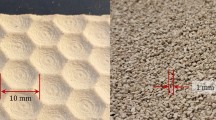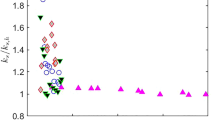Abstract
Wind tunnel measurements of turbulent boundary layers over three-dimensional rough surfaces have been carried out to determine the critical roughness height beyond which the roughness affects the turbulence characteristics of the entire boundary layer. Experiments were performed on three types of surfaces, consisting of an urban type surface with square random height elements, a diamond-pattern wire mesh and a sand-paper type grit. The measurements were carried out over a momentum thickness Reynolds number (Re θ) range of 1,300–28,000 using two-component Laser Doppler anemometry (LDA) and hot-wire anemometry (HWA). A wide range of the ratio of roughness element height h to boundary layer thickness δ was covered (\(0.04 \leq h/\delta \leq 0.40\)). The results confirm that the mean profiles for all the surfaces collapse well in velocity defect form up to surprisingly large values of h/δ, perhaps as large as 0.2, but with a somewhat larger outer layer wake strength than for smooth-wall flows, as previously found. At lower h/δ, at least up to 0.15, the Reynolds stresses for all surfaces show good agreement throughout the boundary layer, collapsing with smooth-wall results outside the near-wall region. With increasing h/δ, however, the turbulence above the near-wall region is gradually modified until the entire flow is affected. Quadrant analysis confirms that changes in the rough-wall boundary layers certainly exist but are confined to the near-wall region at low h/δ; for h/δ beyond about 0.2 the quadrant events show that the structural changes extend throughout much of the boundary layer. Taken together, the data suggest that above h/δ ≈ 0.15, the details of the roughness have a weak effect on how quickly (with rising h/δ) the turbulence structure in the outer flow ceases to conform to the classical boundary layer behaviour. The present results provide support for Townsend’s wall similarity hypothesis at low h/δ and also suggest that a single critical roughness height beyond which it fails does not exist. For fully rough flows, the data also confirm that mean flow and turbulence quantities are essentially independent of Re θ; all the Reynolds stresses match those of smooth-wall flows at very high Re θ. Nonetheless, there is a noticeable increase in stress contributions from strong sweep events in the near-wall region, even at quite low h/δ.













Similar content being viewed by others
References
Bergstrom DJ, Akinlade OG, Tachie MF (2005) Skin friction correlation for smooth and rough wall turbulent boundary layers. ASME J Fluids Eng 127:1146–1153
Bhaganagar K, Kim J, Coleman GN (2004) Effect of roughness on wall-bounded turbulence. Flow Turb Comb 72:463–492
Birch DM, Morrison JF (2010) Similarity of the streamwise velocity component in very-rough-wall channel flow. J Fluid Mech 668:174–201
Castro IP (2007) Rough-wall boundary layers: mean flow universality. J Fluid Mech 585:469–485
Cheng H, Castro IP (2002) Near-wall flow over urban-type roughness. Boundary Layer Meteorol 104:229–259
Coles DE (1987) Coherent structures in turbulent boundary layers. In: Meier HU, Bradshaw P (eds) Perspectives in turbulence studies. Springer, Berlin, pp 93–114
Connelly JS, Schultz MP, Flack KA (2006) Velocity defect scaling for turbulent boundary layers with a range of relative roughness. Exp Fluids 40:188–195
Erm LP, Joubert PN (1991) Low Reynolds number turbulent boundary layers. J Fluid Mech 230:1–44
Fernholz HH, Finley PJ (1996) The incompressible zero-pressure gradient turbulent boundary layer: an assessment of the data. Prog Aerosp Sci 32:245–311
Flack KA, Schultz MP, Connelly JS (2007) Examination of critical roughness height for outer layer similarity. Phys Fluids 19:095104
Flack KA, Schultz MP, Shapiro TA (2005) Experimental support for Townsend’s Reynolds number similarity hypothesis on rough walls. Phys Fluids 17:035102
Grass AJ (1971) Statistical features of turbulent flow over smooth and rough boundaries. J Fluid Mech 50:233–255
Kline SJ, Reynolds WC, Schraub FA, Rundstadler PW (1967) The structure of turbulent boundary layers. J Fluid Mech 30:741–773
Krogstad P-A, Antonia RA, Browne LWB (1992) Comparison between rough- and smooth-wall turbulent boundary layers. J Fluid Mech 245:599–617
Krogstad P-A, Antonia R (1999) Surface roughness effects in turbulent boundary layers. Exp Fluids 27:450–460
Krogstad P-A, Andersson HI, Bakkem OM, Ashrafian A (2005) An experimental and numerical study of channel flow with rough walls. J Fluid Mech 530:327–352
Kunkel GJ, Marusic I (2006) Study of the near-wall turbulent region of the high Reynolds number boundary layer using an atmospheric flow. J Fluid Mech 548:375–402
Jackson PS (1981) On the displacement height in the logarithmic velocity profile. J Fluid Mech 111:15–25
Jiménez J (2004) Turbulent flows over rough walls. Ann Rev Fluid Mech 36:173–196
Leonardi S, Castro IP (2010) Channel flow over large cube roughness: a direct numerical simulation study. J Fluid Mech 651:519–539
Leonardi S, Orlandi P, Smalley RJ, Djenidi L, Antonia RA (2003) Direct numerical simulations of turbulent channel flow with transverse square bars on one wall. J Fluid Mech 491:229–238
Lu SS, Willmarth WW (1973) Measurements of the structure of the Reynolds stress in a turbulent boundary layer. J Fluid Mech 60:481–511
Perry AE, Li JD (1990) Experimental support for the attached eddy hypothesis in zero-pressure gradient turbulent boundary layers. J Fluid Mech 218:405–438
Perry AE, Lim KL, Henbest SM (1987) An experimental study of the turbulence structure in smooth and wough wall turbulent boundary layers. J Fluid Mech 177:437–466
Raupach MR (1981) Conditional statistics of Reynolds stress in rough-wall and smooth-wall turbulent boundary layers. J Fluid Mech 108:362–382
Raupach MR, Antonia RA, Rajagopalan S (1991) Rough-wall turbulent boundary layers. Appl Mech Rev 44:1–25
Reynolds RT, Hayden P, Castro IP, Robins AG (2007) Spanwise variations in nominally two-dimensional rough-wall boundary layers. Exp Fluids 42:311–320
Reynolds RT, Castro IP (2008) Measurements in an urban-type boundary layer. Exp Fluids 45:141–156
Rotta JC (1962) The calculation of the turbulent boundary layer. Prog Aeronaut Sci 2:1–219
Schultz MS, Flack K (2007) The rough-wall turbulent boundary layer from the hydraulically smooth to the fully rough regime. J Fluid Mech 580:381–405
Schultz MP, Volino RJ, Flack KA (2010) Boundary layer structure over a two-dimensional rough wall. In: Nickels T (ed) Proc. of IUTAM symposium on the physics of flow over rough walls. Springer
Tachie MF, Bergstrom DJ, Balachandar R (2000) Rough wall turbulent boundary layers in shallow open channel flow. J Fluids Eng 122:533–541
Tutu N, Chevray R (1975) Cross-wire anemometry in high-intensity turbulence. J Fluid Mech 71:785–800
Townsend AA (1976) The structure of turbulent shear flow, 2nd ed. CUP, p 429
Volino RJ, Schultz MP, Flack KA (2009) Turbulence structure in a boundary layer with two-dimensional roughness. J Fluid Mech 635:75–101
Wallace JM, Eckelmann H, Brodkey RS (1972) The wall region in turbulent shear flow. J Fluid Mech 54:39–48
Wallace JM, Brodkey RS (1977) Reynolds stress and joint probability density distributions in the u-v plane of a turbulent channel flow. Phys Fluids 20:251–355
Wei T, Schmidt R, McMurty P (2005) Comment on the Clauser chart method for determining the friction velocity. Exp Fluids 38:695–699
Acknowledgments
The authors are grateful to the UK’s Engineering & Physical Sciences Research Council, who provided funding for this work under grant number EP/D036771, and to staff in the School of Engineering Sciences’ workshop, who provided willing and excellent technical support throughout the experimental programme. We also thank Paul Hayden of the University of Surrey for his valuable support with the EnFlo software used for all our data collection and Karen Flack, Per-Åge Krogstad, Jonathan Morrison and David Birch for helpful discussions.
Author information
Authors and Affiliations
Corresponding author
Rights and permissions
About this article
Cite this article
Amir, M., Castro, I.P. Turbulence in rough-wall boundary layers: universality issues. Exp Fluids 51, 313–326 (2011). https://doi.org/10.1007/s00348-011-1049-7
Received:
Revised:
Accepted:
Published:
Issue Date:
DOI: https://doi.org/10.1007/s00348-011-1049-7




